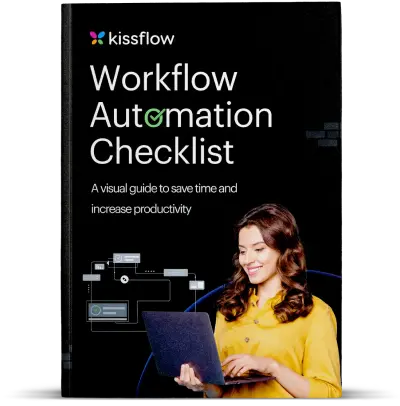
- >
- Workflow >
- Workflow Automation In Finance: Accuracy, Compliance, And Profitability Combined
Workflow Automation In Finance: Accuracy, Compliance, And Profitability Combined
Your finance team processes hundreds of transactions daily. Each one carries risk. A miskeyed number could mean a six-figure error. A missed compliance flag could trigger regulatory penalties. A delayed approval could damage vendor relationships or miss payment discounts.
Manual approval workflows amplify these risks. Spreadsheets get corrupted. Emails go unnoticed. Approval chains break when someone's on vacation. The controls you designed work perfectly until they don't, and in finance, one failure can be expensive.
AI workflow automation in finance isn't about eliminating jobs. It's about eliminating the errors, delays, and compliance gaps that manual processes create. And it's about freeing your finance team to do actual financial analysis instead of data entry and approval chasing, driving both accuracy and profitability.
The cost of manual finance processes
Finance operations deal with numbers all day, but rarely calculate the cost of their own inefficiency. The numbers are sobering when you examine banking workflow management benefits versus manual operations.
Manual invoice processing costs organizations an average of $15 to $40 per invoice, according to Ardent Partners research. For a mid-sized company processing 10,000 invoices annually, that's up to $400,000 in processing costs alone. AI finance workflows drop that cost to under $5 per invoice, directly improving profitability.
But processing costs are just the visible expense. The hidden costs of inadequate AI compliance automation run deeper.
Error rates in manual data entry range from 1% to 4%, depending on complexity. In finance, where a misplaced decimal point can mean a hundred-fold error, even a 1 percent error rate is unacceptable. Each error requires discovery, investigation, correction, and often reconciliation across multiple systems. The accuracy impact is significant.
Compliance violations carry even steeper costs. The average cost of non-compliance reached $14.82 million per organization in 2024, according to compliance industry research. Many of these violations stem from process failures where required controls weren't followed or documented properly. AI compliance automation addresses these risks systematically.
Then there's the opportunity cost. Your finance team spending 30 hours a week on transaction processing is 30 hours not spent on financial planning, analysis, or strategic initiatives that drive profitability. You're paying professionals to do work that AI finance workflows handle better.
Automating accounts payable for speed and accuracy
Accounts payable sits at the intersection of vendor relationships, cash flow management, and compliance requirements. Manual AP processes struggle with all three. Banking workflow automation transforms this critical function.
AI workflow automation in finance starts when an invoice arrives, regardless of format. The system extracts data from PDFs, emails, or EDI formats with high accuracy. It matches invoices to purchase orders automatically. It validates pricing, quantities, and terms. It routes discrepancies to the right person for resolution. It moves approved invoices through the payment workflow based on due dates, early payment discounts, and cash flow optimization.
The approval chain adjusts dynamically through AI finance workflows. New vendor invoices get additional scrutiny. Repeat vendors with good history move faster. Invoices that match purchase orders exactly can auto-approve within policy limits. High-value or unusual invoices escalate appropriately, maintaining compliance while optimizing speed.
Organizations implementing AP automation report 81 percent faster invoice processing times and error rates below 0.5 percent, according to Tipalti's benchmark survey. That speed and accuracy translate to captured early payment discounts, better vendor relationships, reduced processing costs, and improved profitability.
Accounts receivable workflows that accelerate profitability
Cash tied up in receivables can't fund operations or growth. Manual AR processes create unnecessary delays in getting paid, directly impacting profitability. AI workflow optimization in finance accelerates cash collection.
AI finance workflows generate invoices immediately when billing triggers occur. They deliver invoices through each customer's preferred channel. They track payment due dates and send automated reminders before invoices become overdue. They escalate collection activities based on customer history, relationship value, and payment patterns, optimizing for both accuracy and customer relationships.
The system identifies patterns that indicate payment problems early. When a customer who typically pays within 15 days hasn't paid after 20, the workflow alerts the relationship manager before it becomes a serious collections issue. When payment trends change across multiple customers in a sector, it flags potential market issues that might require proactive credit management and compliance review.
Workflow integration with payment gateways makes paying easier for customers through banking workflow automation. They receive invoices with embedded payment links. They can pay directly without logging into separate portals or writing checks. Friction disappears. Cash arrives faster, improving profitability.
Companies using automated AR workflows reduce their days sales outstanding (DSO) by an average of 20 to 30 percent, according to HighRadius research. That's working capital freed up for more productive uses, directly impacting profitability.
Expense management that balances control and accuracy
Employee expense management creates tension between control and user experience. Tight controls make submission painful. Loose controls invite fraud and policy violations. AI compliance automation resolves this tension.
AI workflow automation in finance enables employees to submit expenses through mobile apps, often by simply photographing receipts. The system extracts data from the receipt image with high accuracy, categorizes the expense, and checks policy compliance automatically.
Policy violations get flagged immediately through AI finance workflows. An expense over the daily meal limit prompts for explanation. A missing receipt triggers a reminder. A suspicious pattern across multiple expenses alerts for review. But compliant expenses flow through quickly, often auto-approving based on amount, category, and employee history.
Managers only see exceptions requiring their judgment. Their team's legitimate business expenses don't pile up in their approval queue. They focus on the 10 percent of expenses that need scrutiny, not the 90 percent that are routine. This maintains compliance while optimizing efficiency.
The workflow orchestrates with corporate cards through banking workflow automation, automatically matching card transactions to submitted expenses and flagging unsubmitted charges. Reimbursements happen faster. Compliance improves. The finance team spends less time chasing missing receipts and more time analyzing spending patterns for profitability opportunities.
Organizations implementing automated expense management reduce processing time by 75 percent while improving policy compliance rates above 95 percent, according to SAP Concur research.
Financial close processes that compress cycles with accuracy
Month-end and quarter-end close processes consume enormous time while creating risk. Manual reconciliation, journal entries, and reporting workflows introduce errors that require investigation and correction, delaying close and impacting accuracy.
AI enterprise workflow management software in finance orchestrates close activities across teams and systems. It triggers reconciliation workflows on schedule. It validates that required tasks are complete before allowing progression to the next stage. It automatically generates standard journal entries based on transactional data. It compiles financial reports by pulling data from multiple sources with high accuracy.
The system identifies exceptions early in the close cycle when there's still time to resolve them. AI finance workflows flag reconciliations that don't balance, missing documentation, and unusual variances that require explanation. Finance teams address issues proactively instead of discovering them during final review.
Integration with AI compliance automation ensures that all required controls execute during close. Segregation of duties gets enforced automatically. Approval requirements follow policy. Audit trails capture every action for compliance review.
Organizations implementing automated close processes reduce close time by 30 to 50 percent while improving accuracy and compliance, according to BlackLine research. Finance teams shift from firefighting during close to analyzing results and providing insights that drive profitability.
Fraud detection through intelligent pattern recognition
Financial fraud costs organizations billions annually. Traditional controls catch obvious violations but miss sophisticated schemes that exploit process gaps. AI workflow automation tools in finance provides continuous monitoring with pattern recognition that humans can't match.
The system analyzes transactions for anomalies in real time. It recognizes when an invoice comes from a new vendor that closely resembles an existing vendor name. It flags expense patterns that suggest split purchases designed to avoid approval thresholds. It identifies payment instructions that differ from historical patterns for the same vendor.
AI finance workflows learn normal patterns for each vendor, customer, and employee. When transactions deviate from those patterns, the system escalates for review. This catches fraud attempts earlier while reducing false positives that waste investigator time, improving both accuracy and compliance.
Integration with banking workflow automation extends monitoring to payment execution. The system validates payment details against approved invoices, flags changes to bank account information, and applies velocity checks to prevent multiple fraudulent payments.
Financial institutions using AI-powered fraud detection report 70 percent reduction in fraud losses while decreasing false positive rates, according to McKinsey research.
Compliance automation that reduces risk and cost
Regulatory requirements in finance continue to expand. Manual compliance processes struggle to keep pace. Controls get skipped during busy periods. Documentation is incomplete. Audit preparation becomes painful. AI compliance automation transforms this challenge.
AI workflow application in finance embeds compliance controls directly into operational workflows. Required approvals can't be bypassed. Segregation of duties gets enforced automatically. Workflow documentation requirements are built into each process step. Every action creates audit trail entries with high accuracy.
The system monitors for regulatory changes and flags where workflow updates are needed. It tracks compliance metrics in real time, providing early warning when processes drift from requirements. It simplifies audit preparation by organizing evidence automatically.
AI finance workflows adapt to different regulatory requirements across jurisdictions. Multi-national organizations implement consistent core processes with jurisdiction-specific compliance variations. The system ensures local requirements are met while maintaining global standards.
Organizations with automated compliance workflows experience 28 percent lower data breach costs compared to those using manual compliance processes, according to the Ponemon Institute. They also spend significantly less time on audit preparation while achieving better audit outcomes.
Building the business case for AI finance workflows
The case for AI workflow automation in finance rests on quantifiable improvements in accuracy, compliance, and profitability. Calculate your current costs of manual processing, error correction, compliance violations, and delayed decisions.
Project the improvements from banking workflow automation across key metrics: processing costs, cycle times, error rates, compliance violations, and working capital optimization. Most organizations see ROI within 12 to 18 months with continuing benefits as AI finance workflows drive continuous improvement.
Factor in risk reduction. Each compliance violation prevented, fraud attempt stopped, and error eliminated represents material value beyond operational efficiency. The accuracy improvements from AI workflow automation in finance protect profitability while enabling growth.
How Kissflow helps
Kissflow's low-code workflow automation platform enables finance teams to build AI finance workflows that match their specific requirements without custom development. Design approval processes that enforce segregation of duties and compliance controls. Build reconciliation workflows that integrate with your ERP and banking systems. Create reporting workflows that compile data from multiple sources with accuracy and speed.
The visual builder lets finance teams design and modify banking workflow automation platform without waiting for IT resources, so you can adapt to regulatory changes and business needs while maintaining the AI compliance automation that protects your organization.
Transform your finance operations with intelligent workflow automation
Related Topics:

Kissflow's Complete Guide To Workflow Automation
Thank you for downloading the ebook!
Related Articles











